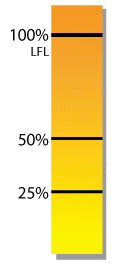
Almost all safety authorities require a 4:1 margin of safety below the LFL, based on worst-case conditions. This means that enough dilution air must be used to always maintain a concentration of less than 25% of the LFL, according to the National Fire Protection Association standard NFPA 86.
- However, a process dryer or oxidizer is allowed to operate with only a 2:1 safety margin (up to 50% of the LFL), when continuous flammability analyzers are used. The requirements stipulate real-time, fast-response, continuous analyzers connected in such a manner as to trigger corrective action at predetermined alarm points.
- Therefore, unprotected processes, which may normally run at only 10% or 12% LFL to avoid reaching 25% in case of accidental upset, are allowed to operate at much higher vapor concentrations when LFL analyzers are used. The resulting cost savings due to reduced ventilation or increased throughput can be considerable. For example, using the energy of the solvent-laden air through recirculation and damper control can reduce the cost of providing the air at the required temperature for the process.
- There are variations in the Lower Flammable Limit values published by different authorities. These variations may be due to small inaccuracies in test procedures. A comparison of the LFL value for fifty common solvents, published by six different authorities, shows that one-third of the solvents compared disagree by a standard deviation of more than ten percent. Given these differences, the LFL of a substance is certainly not an absolute value and ample allowances should be made to ensure safe operation.

Add new comment